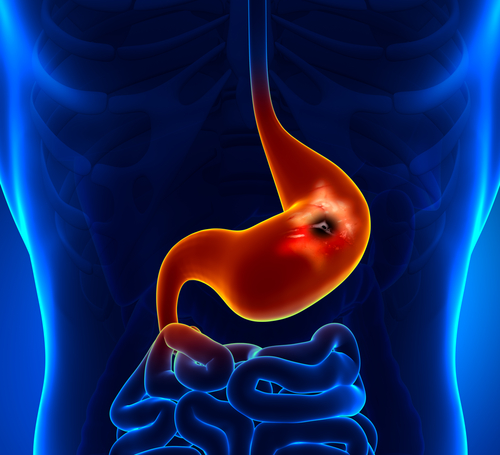Stomach Ulcer
Definition of Stomach Ulcer
The stomach is a bag like organ of digestive system which is present on left side of the abdomen. It is responsible for breakdown and digestion of food, specially the proteins. Normally the walls of stomach are covered by protective, thick and slimy fluid called mucus. Strong acid is produced by stomach for breakdown and digestion of food. The thick mucus covering walls of the stomach protect the walls of stomach from digestion by this strong acid. Hence, the strong acid produced inside stomach only acts on food that is present inside the stomach.
When the protective mucus lining of stomach is disrupted, this results in production of open, painful sores on the wall of the stomach. These painful sores inside stomach are called stomach ulcers. The underlying tissue of stomach wall is exposed in case of the ulcers. The ulcer caused by stomach acid is called peptic ulcer. There are many types of peptic ulcer (esophageal, gastric and duodenal) and the stomach ulcer is one of them.

Cause of Stomach Ulcer
Naturally, there is a certain balance between the production of stomach acid and mucus production. In some cases, the production of mucus is decreased or the acid production in stomach is increased that results in disruption of the mucus lining of the stomach, thus causing ulcers in the wall of the stomach. Following are the most common causes of stomach ulcers:
-
Frequent use of certain medicines like NSAIDS (pain killers and results in decreased mucus production)
-
Infection of stomach by H.pylori bacteria
-
Gastrinoma (due to increased acid production)
-
Gastric tumors (due to increased acid production)
-
Zollinger-Ellison syndrome (It is a gastric tumor that increase acid production)
-
Smoking
-
Alcohol consumption
-
Radiation therapy
Signs and Symptoms of Stomach Ulcer
Ulcer does not always produce signs and symptoms. In case, the ulcer shows signs and symptoms (like when they are properly developed); there are generally no typical signs and symptoms associated with stomach ulcer (except the burning pain in abdomen). Following are the signs and symptoms shown by stomach ulcer patient (not all the signs and symptoms are necessarily shown by the patient):
-
Abdominal (central and on right side) burning pain at night or after meals. Pain can travel to belly button, back or towards neck
-
Heartburn
-
Nausea
-
Vomiting
-
Bloating
In case of severe disease, the additional signs and symptoms may be shown, which may include:
-
Black feces (due to bleeding from walls of stomach)
-
Coffee grounds or red colored vomit (due to bleeding from walls of stomach)
-
Weight loss (due to indigestion of food)
-
Severe burning pain in abdomen (upper and mid part of abdomen)
-
Sick feeling
-
Changes in apatite
-
Light headedness (due to loss of blood and resulting anemia)
-
Signs of indigestion of food
- Intolerance to spicy and fatty food etc
Risk Factors for Stomach Ulcer
Following are the most common risk factors that are involved in the development of stomach ulcer:
-
Transmission from an infected person (of H.pylori bacterium)
-
Side effect of some medicines (like aspirin which is a commonly used pain killer)
-
Stress
-
Psychological factors
-
Smoking
-
Family history of ulcers
-
Old age (above 50 years)
-
Alcoholics
-
Smokers
-
Presence of other diseases (like liver, kidney and lung etc)
Diagnosis of Stomach Ulcer
A physician makes diagnosis of stomach ulcer by:
-
Noticing the signs and symptoms of the patient on taking patient’s history
-
Upper endoscopy
Insides of stomach are visualized on monitor using an endoscope. The endoscope is a thin and flexible tube having cameras at its rear end. That end is passed through mouth and esophagus to the stomach.
-
Biopsy of stomach
Portion of stomach is taken for examination.
-
Barium meal
It is a type of x-rays. It is not a common procedure but can be a good replacement if endoscope is not available.
-
Urea breath test
This test is used to check whether the ulcer is due to infection by H-pylori
-
Stool antigen test
Sample of stool is tested to check antigen’s presence (of H-pylori)
-
A blood test
Antibodies for H-pylori are tested in blood to check whether the ulcer is due to infection by H-pylori
Prevention from Stomach Ulcer
Following preventive measures may be helpful to reduce the risk of developing the stomach ulcer:
-
Less alcohol consumption
-
No smoking
-
Less use of NSAIDS (like aspirin)
-
Living less stressful life
Treatment of Stomach Ulcer
-
Life style modification
Taking proper control of the disease which includes less consumption of alcohol, no smoking and avoiding spicy and fatty meals etc
-
Medication
This includes antibiotics in case of infection by H-pylori, usage of drugs that reduce the acid production of stomach, usage of drugs that increase mucus production and usage of drugs that helps in healing process of stomach ulcer.
-
Surgery
In case the ulcer is very severe and is not getting better with medication and other preventive measures, surgery can be the end solution. In that case, the nerves that supply to stomach walls and are responsible for acid production in stomach are cut to decrease acid production. It is not a good choice.
If the ulcer is not treated properly, it can result in serious health conditions, like:
-
Profuse bleeding
-
Perforation of stomach
-
Obstruction of exit passage of stomach (due to inflammation or scarring)
-
Shock due to excessive loss of blood
